Back in 1999 when the editors of Sensors launched the Best of Sensors Expo Awards, we wanted to recognize innovative new products that promised to have a strong impact on the sensing industry and to highlight them at Sensors Expo. The new products we considered had to meet our requirements of timeliness, uniqueness, utility, and the ability to change the way people work. This year we've expanded the program to highlight the ways sensors are used in the wider world and to recognize the people responsible for creating and using them.
One of the most visible changes is the creation of new categories of awards. These include the The Engineers of the Year Award to recognize engineering teams, the Application Award to recognize exciting sensor applications, and the Innovation Award to recognize new and noteworthy sensor products. The judges—Karen Lightman of the MEMS Industry Group, Dr. Sergey Yurish of IFSA, Randy Frank of Randy Frank & Associates, and Melanie Martella of Sensors—sifted through the many excellent nominations to choose our award winners.
Engineers of the Year Award
Our intent with this award is to recognize the people behind the technologies; the individuals and engineering teams who, through practical innovation, have advanced the sensor industry. Whether their efforts involve developing completely new types of sensors or applying sensors in a novel way, we look on this award as a way to thank them for their endeavors.
Because so many developments in the sensor industry are the work of engineers working together, we wanted this award to reflect this reality. As a result, this award is for engineering teams who have provided an outstanding contribution to the sensors industry, either through the development of sensor technology or by its application to address real-world problems.
The winners of the inaugural Engineers of the Year Award are Kenneth Foust of Intel and Carlos Puig of Qualcomm for their creation, in collaboration with a number of sensor manufacturers, of the Standardized Performance Parameter Definitions (PDF). This effort provides a common methodology for describing the performance parameters of the sensors that are most commonly used in consumer devices. The intent is to allow designers to more easily compare product specifications and thus ease integration and speed time to market. Considering how lengthy and contentious standards development can be, it is also impressive that Ken and Carlos managed to move this important standardization initiative from conception to first draft release in only four months.
Application Awards
Our goal with this award category is to recognize and draw attention to some of the amazing sensor applications that exist. Sensor applications are, at their heart, systems that use sensors to gather information for a specific aim. While some of the applications may use new types of sensors, many of them will represent a novel use of existing, mature sensing technologies.
The Gold Application Award goes to The Sensor Web Enablement Initiative from the Open Geospatial Consortium. This initiative standardizes Web service interfaces and data encodings to create building blocks for a world wide sensor web, creating a framework of open standards to allow diverse Web-connected sensors and sensor systems to be accessed in an interoperable, platform-independent, and uniform way for use in disaster management, remote sensing, environmental monitoring, public safety, and many other applications. As Randy Frank observed, "This is an extensive standards effort and it could have a huge impact."
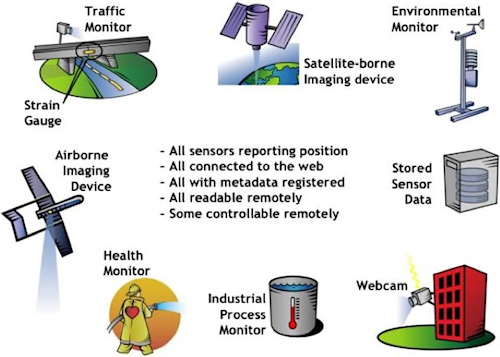 The Open Geospatial Consortium's Sensor Web Enablement Initiative |
The Silver Application Award goes to the S3 from SENSUSS. The S3 itself is a wireless helmet-mounted impact logger that transmits data to the Eurotech Everyware Cloud where it can be used to provide immediate information on the impact levels experienced by an athlete to coaches, doctors, and parents. Considering how dangerous traumatic brain injuries can be, the ability to assess quickly just how hard a hit an athlete has just taken is extremely valuable. Or, as Karen Lightman succinctly put it, "Yes! This is so important!"
 The SENSUSS S3 helmet-mounted impact logging system |
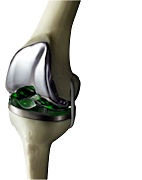 The OrthoSensor VeraSense Total Knee Alignment system |
The Bronze Application Award goes to The VeraSense Knee System from OrthoSensor. Knees are complicated joints; when a knee replacement is performed, one of the issues that patients run into is that the tissues surrounding and stabilizing the knee are out of whack and the resulting joint isn't stable. The VeraSense Knee System is an intelligent tibial insert trial that provides sensor-based information to surgeons performing total knee replacements so that they can assess during surgery the loads experienced by the knee and how those loads are aligned, through the full range of motion of the knee. The result is a more stable post-operative joint and a happier and healthier patient.
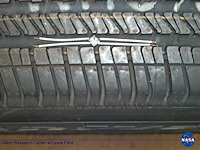 The thin-film heat flux sensor developed by Goodyear Tire & Rubber Co. and NASA-Glenn Research Center |
An Honorable Mention goes to the Goodyear Tire & Rubber Co. and NASA-Glenn Research Center who have created a thin-film flexible heat flux sensor that gives real-time temperature and transient heat-flux data for both the inner and outer surfaces of a tire as it is moving; it's small, thin, fast, robust, and it's got applications beyond tires! NASA can also use it to test the thermal control on its next-generation pressure suits for future lunar missions. Observed Dr. Yurish, "This offers a new lab procedure."
Innovation Award Winners
The Innovation Award is, in its essentials, the same as our traditional Best of Sensors Expo program in that it focuses on new sensor and sensor-related products that exhibit the qualities of timeliness, uniqueness, utility, and that have the potential to change the way people work.
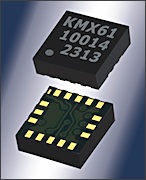 The KMX61G from Kionix |
This year we have two Gold Innovation Awards. The first Gold Award goes to Kionix for its KMX61G magnetic gyro. This combination accelerometer and magnetometer provides a lower-power alternative to a gyroscope for consumer electronics, creating a 9-axis motion sensing system from a 6-axis magnetometer/accelerometer combined with device sensor fusion software and calibration algorithms working together to generate accurate emulated gyroscope outputs. As Melanie Martella notes, "There are a number of devices that, because of their stringent power consumption constraints have been unable to use gyroscopes because of the power demands involved with their use. This device, by providing low-power gyroscope emulation, puts that functionality within their reach."
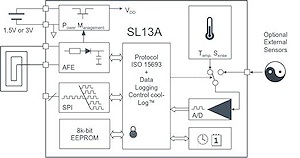 The SL13A NFC Sensory Tag IC from ams AG |
Our second Gold Innovation Award goes to ams AG for its SL13A NFC Sensory Tag IC. This single-chip combination NFC/RFID tag is optimized for single-cell, battery-powered smart labels and incorporates sensor functionality through a built-in temperature sensor and an external sensor interface. Suited for use in applications using thin and flexible batteries, the chip can also be powered from the RF field. The NFC capability means that as long as you have an NFC-enabled device with the appropriate app you can read the tag; you don't need an installed RFID infrastructure, although the tag works with RFID, too. As Frank said, "It's a good execution that fulfills the promised trend in asset monitoring." It's powerful, flexible, and can be used for autonomous long-term asset tracking and monitoring for things such as buildings and transportation along with a number of other uses.
Our Silver Innovation Award goes to LORD MicroStrain Sensing Systems for its MathEngine cloud-based sensor data analysis and alerting technology. MathEngine lets you create, store, and edit applications on wireless sensor networks from any Web-connected terminal. Its support for Python and Octave lets you create virtual sensing channels based on mathematical relationships. The result is a strong, cloud-based toolbox for asset monitoring applications. As Lightman noted, "This is amazing—I want one to help manage my life!"
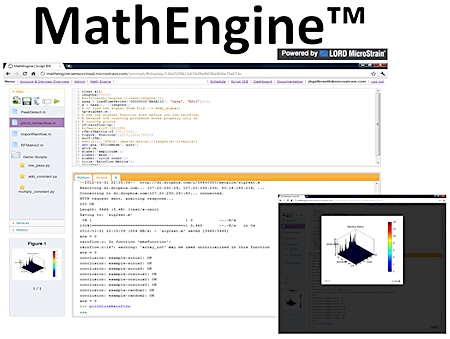 MathEngine from LORD MicroStrain Sensing Systems |
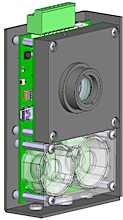 The Leddar 3D detection platform from LeddarTech |
Our Bronze Innovation Award goes to LeddarTech for its Leddar LED-based 3D detection platform. This 3D sensing technology measures the time-of-flight of pulses of LED light to provide detection and ranging for distances up to 50 m and in severe environmental conditions. It's an interesting alternative to other detection technologies such as laser, radar, video, thermal imaging, ultrasonic, and passive IR.
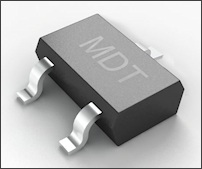 The MMS2A1H from MultiDimension Technology |
The first Innovation Award Honorable Mention goes to MultiDimension Technology for its MMS2A1H ultra-low-power omnipolar TMR magnetic switch. The device draws 1.5 µA at a 1 kHz frequency response; has operate and release switch points at ±10 Gauss and ±17 Gauss; and the device is housed in a SOT23 package. The combination of size, sensitivity, stability, and ultra-low-power operation made this switch a winner with the judges.
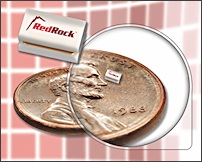 The RedRock RS-A-2515 from COTO Technology |
Our second Innovation Award Honorable Mention goes to COTO Technology for its RedRock RS-A-2515 MEMS-based magnetic switch. Dr. Yurish was impressed at the impressed at the engineering in this tiny 1.125 by 2.185 by 0.95 mm device. Features include zero power operation, closure sensitivity from 5 to 25 mT for operation up to 20 mm using a small NdFeB magnet, a release sensitivity of <15 mT, and wafer-level packaging. Because of its high-aspect ratio structure, it can handle several hundred milliwatts of hot switching (a max. switching voltage of 100 VDC with a switching current of 50 mA DC or 35 mA AC, RMS) and has high retract forces to prevent the switch from sticking shut.
The judges and I congratulate this year's winners!
Melanie Martella is Executive Editor, Sensors magazine, Newton, MA. She can be reached at 603-924-3246 or [email protected].